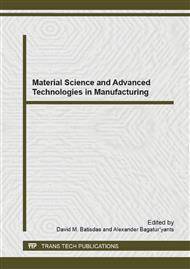[1]
Zhu Xiaofan. Study on Flue Gas Desulphurization with Pyrolusite Pulp[D]. Sichuan University, Chengdu, (2001).
Google Scholar
[2]
Chen Juan, Cui Shuqing. Study on the Sulfur Dioxide Effluent Causing a Problem to People's health and its related problems[J]. Inner Mongolia Water Resources, 2012, (3): 174-175.
Google Scholar
[3]
He Jiming. Study on China Energy Planning Considering the Prevention and Control of Atmospheric Pollution[M]. China Environmental Sciences Press, Beijing, (1995).
Google Scholar
[4]
2011 China's Environmental Status Bulletin[EB]. (2011).
Google Scholar
[5]
Shen Yafei, Sun Tonghua, Jia Jinping. Novel Desulphurization Method of Sodium Borohydride Reduction for Coal Water Slurry[J]. Energy Fuels, 2011, 25(7): 2963-2967.
DOI: 10.1021/ef200657c
Google Scholar
[6]
Satyabrata Mohanta, Sudipto Chakraborty, B. C. Meikap. Influence of Coal Feed Size on the Performance of Air Dense Medium Fluidized Bed Separator Used for Coal Beneficiation[J]. Ind. Eng. Chem. Res., 2011, 50(18): 10865-10871.
DOI: 10.1021/ie201548r
Google Scholar
[7]
Li Jia, Lu Hongzhou, Guo Jie, et al. Recycle Technology for Recovering Resources and Products from Waste Printed Circuit Boards[J]. Environmental Science Technology, 2007, 41(6): 1995-(2000).
DOI: 10.1021/es0618245
Google Scholar
[8]
Romuald P. Bokotko, Jan Hupka, Jan D. Miller. Flue Gas Treatment for SO2 Removal with Air-Sparged Hydrocyclone Technology[J]. Environmental Science Technology, 2005, 39(4): 1184-1189.
DOI: 10.1021/es035044x
Google Scholar
[9]
Zhang Yanhong, Qian Peng, Liu Yi, et al. Experimental Study of Hydrocyclone Flow Field with Different Feed Concentration[J]. Industrial and Engineering Chemistry Research, 2011, 50(13): 8176-8184.
DOI: 10.1021/ie100210c
Google Scholar
[10]
Xu Yanxia, Song Xingfu, Sun Ze, et al. Simulation Analysis of Multiphase Flow and Performance of Hydrocyclones at Different Atmospheric Pressures[J]. Industrial and Engineering Chemistry Research, 2012, 51(1): 443-453.
DOI: 10.1021/ie201147e
Google Scholar
[11]
Lin C.L., Liu Y.A. Desulphurization of Coals by High-Intensity High-Gradient Magnetic Separation: Conceptual Process Design and Cost Estimation[M]. Coal Desulphurization, ACS Symposium Series, 1977: 121-139.
DOI: 10.1021/bk-1977-0064.ch010
Google Scholar
[12]
Huang D. Wang Y.J., Yang L.M., et al. Chemical Oxidation of Dibenzonthiophene with a Directly Combined Amphiphilic Catalyst for Deep Desulphurization[J]. Industrial and Engineering Chemistry Research, 2006, 45(6): 1880-1885.
DOI: 10.1021/ie0513346
Google Scholar
[13]
Yasuhiro Shiraishi, Kenya Tachibana, Takayuki Hirai, et al. Desulphurization and Denitrogenation Process for Light Oils Based on Chemical Oxidation followed by Liquid-Liquid Extraction[J]. Industrial and Engineering Chemistry Research, 20062, 41(17): 4362-4375.
DOI: 10.1021/ie010618x
Google Scholar
[14]
Wei Yuxia, Xiao Baoqing, Yan Hai, et al. Screen and Activity of Dibenzothiophene by Desulphurization Mcrobe Strain[J]. China Environmental Science, 2006, 26(3): 311-314.
Google Scholar
[15]
Nicholas E. Leadbeater, M. Rashid Khan. Microwave-Promoted Desulphurization of Heavy and Sulfur-Containing Crude Oil[J]. Energy and Fuels, 2008, 22(3): 1836-1839.
DOI: 10.1021/ef7007198
Google Scholar
[16]
Wei Zaishan, Zeng Guihua, Xie Zhirong. Microwave Catalytic Desulphurization and Denitrification Simultaneously on Fe/Ca-5A Zeolite Catalyst[J]. Energy and Fuels, 2009, 23(6): 2947-2951.
DOI: 10.1021/ef801013w
Google Scholar
[17]
Shen Zhigang, Guo Shaopeng, Kang Wanzhong, et al. Kinetics and Mechanism of Sulfite Oxidation in the Magnesium-Based Wet Flue Gas Desulphurization Process[J]. Industrial and Engineering Chemistry Research, 2012, 51: 4192 4198.
DOI: 10.1021/ie300163v
Google Scholar
[18]
Chen Hui, Ge Honghua, Dou Binlin, et al. Thermogravimetric Kinetics of MgSO3•6H2O Byproduct from Magnesia Wet Flue Gas Desulphurization[J]. Energy and Fuels, 2009, 23: 2552-2556.
DOI: 10.1021/ef900083f
Google Scholar
[19]
Li Yan, Masateru Nishioka, Masayoshi Sadakata. High Calcium Utilization and Gypsum Formation for Dry Desulphurization Process[J]. Energy and Fuels, 1999, 13: 1015-1020.
DOI: 10.1021/ef9802781
Google Scholar
[20]
Amedeo Lancia, Dino Musmarra. Calcium Bisulfite Oxidation Rate in the Wet Limestone- Gypsum Flue Gas Desulphurization Process[J]. Environmental Science Technology, 1999, 33: 1931-(1935).
DOI: 10.1021/es9805425
Google Scholar
[21]
Nie Lijun. Dry Technology of Flue Gas Desulphurization[J]. Chongqing Environmental Science, 2003, 25(2): 50-52.
Google Scholar
[22]
Jin Wen-hai, Shi Feng-shen. Process-optimization for Rotating Spray Dryer-flue Gas Desulphurization(FGD) [J]. Environment and Ecology in the Three Gorge, 2011, 33(5): 33-37.
Google Scholar
[23]
Zhao Guanglin. Theoretical Study for Sulfur Dioxide Absorption on Limestone Wet Flue Gas Desulphurization [D]. Northeastern University, Shenyang, (2008).
Google Scholar
[24]
Mbango Mbida K. G., Song Cunyi, Zhou Xiang. Research on Dual-alkali Process Regeneration Phase for Sintering Flue Gas Desulphurization[J]. Environmental Engineering, 2012, 30(3): 127-130.
Google Scholar
[25]
Huang Lina, Miao Mingfeng, Chen Maobing, et al. Comparison between limestone -gypsum and ammonia wet flue gas desulphurization technologies[J]. Electric Power Technology and Environmental Protection, 2011, 27(5): 26-28.
Google Scholar


